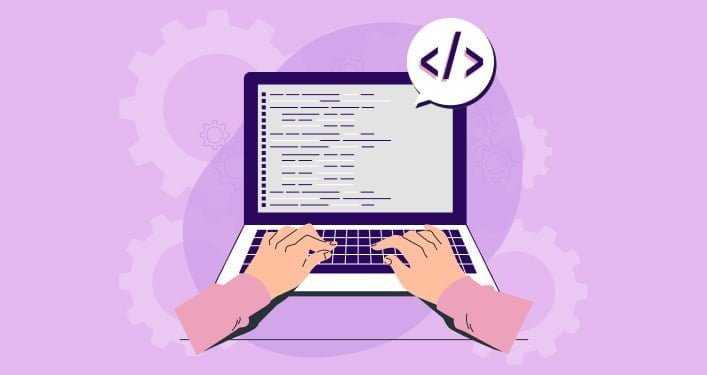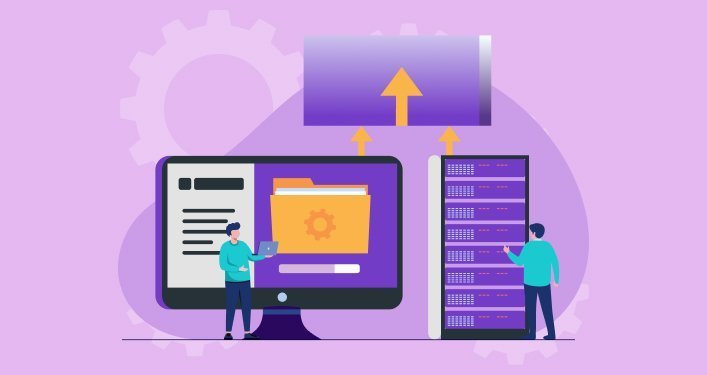The reasons behind a
highly scalable frontend
Proper arrangement of these components results in a highly scalable frontend:
Multi-layered Management
It requires an equally good blend of backend and frontend structures to perform a variety of tasks, from traffic control to introducing new features and maintaining UI consistency at the front end. The scalability of your program depends on this synergy, which also makes the creation and maintenance procedures simpler.
The system can be divided into the following layers, creating a multi-layered design that dramatically improves speed and scalability.

Domain:
It is a separate layer that consists of cluster information related to business and people or organizations participating in it and helps in defining the use cases for multiple processes in the application when it is reused by the other layers.
Application:
The application layer decides the nature of the application. It interacts with the single sets of domain layers, deals, and processes the information held by the domain layer for the other layers to use it.
Infrastructure:
All external aspects of the application are taken care of by this layer. Storing data, giving access to store the data, email services, queue engines, and it is also responsible for all the systems working together internally as well as externally.
Input/Output:
This layer procures the data for the end user from the system. The application is interactive and the users can summon any program-related data, this layer will provide it.
Businesses will have to get more alert about the frontend, component-based design, and headless architecture among others as they will realize how important it is to adapt modern architecture. All of these strategies work to accelerate deployments by ending dependencies between different components.
Flexible Framework:
A front end framework serves as an aid to maintain the user experience as your application grows. A clean app structure, fluid page routing, reusable components, manageable code, and interfaces with external libraries are all introduced. With these tools, one is able to develop applications with a solid framework, a user-friendly interface, and extensively tested code. The framework’s community is available for frontend developers to reach out to if they encounter any difficulties while making the application.
Nevertheless, it’s critical to keep in mind that, irrespective of trends, you must select a framework that is compatible with the standards of your organization and the target market. The top most used frameworks are React, Angular, and Vue, which are chosen by the biggest software companies worldwide.
React allows the re-use of the code, and by selecting it for your project, you can significantly reduce the time it takes to build a project in its entirety. You can ensure that data maintained in your parent and child components are updated simultaneously by using Angular’s two-way data binding functionality. On the other hand, the adaptable design architecture provided by Vue provides your teams the ability to develop apps that suit their unique development methodologies.

Clean Code :
Scalable code must also be autonomous, adaptive, readable, and maintainable. Your teams should be able to reuse it with few to no changes. It’s also vital that adding pull requests or merging codes doesn’t result in further problems. In a similar vein, such code needs to be rapidly picked up by new frontend developers without having any bad consequences on the development process when a frontend developer leaves a team.
The process of development ought to include testing as a crucial step. Before releasing the software, you shouldn’t rely solely on manual testing of the code. Always guarantee complete testing coverage, and if that proves to be impossible, consider restructuring the code. Remember that untested code can result in potential bugs and a number of functional issues in your program. When the codes have been properly tested, removing bugs requires the least time. If you continue to run into errors, you may isolate the problematic code and correct it right away, protecting your users from any inconvenience.
As every frontend developer can use clean code, it provides the greatest scalability. It’s advised that you write thorough documentation so that your team is aware of the accepted procedures for naming variables, functions, classes, and other things. Moreover, individual codes should be held responsible for one task and only allowed for minor changes, which will help in calling them more efficiently and spontaneously.

Technical/Tactical Testing :
Everything that is live on the app must be extensively tested in order to ensure a quick and consistent user experience. Testing quickly does not produce the greatest outcomes. First of all, testers need to be fully informed about the applications they will be testing. Then, to eliminate any potential human mistake, they should make full use of the technologies that enable the testing. Setting a budget and a schedule for completing the tests is also vital. More significantly, you should think about utilizing automation and continuous testing to free up your team’s time from tedious repetitive chores so they can concentrate on more difficult problems.
Now that we have seen what factors are responsible for scaling a frontend, let’s understand how to achieve scalability with some of the best software development principles.
Anything that is live on the app must be extensively tested in order to ensure a quick and consistent user experience. Testing everything quickly, on the other hand, does not produce the greatest outcomes. First and foremost, testers need to know exactly what to test in an application. Then, to eliminate any potential human mistake, they should make full use of the technologies that enable the testing. Setting a budget and a schedule for completing the tests is also vital. More significantly, you should think about utilizing automation and continuous testing to free up your team’s time from tedious repetitions so they can concentrate on more difficult problems.
After examining the elements that contribute to frontend scalability, let’s consider how to accomplish scalability using some of the greatest software development concepts.

Boosting scalability
Dynamic storage :
The complexity of monitoring logs increased when software design shifted from antiquated systems to remote computing systems. It can be difficult for frontend developers to retrieve logs in emergency situations when they are dispersed across several systems, cause a severe storage space scarcity, or serve only one process and lack context. This shortcoming might cause delays in code creation, testing, or deployment, which further reduces the capacity to scale.

Regular touch-ups :
Coming out with frequent updates, updating functionalities, and adopting frameworks in accordance with project objectives is one of the numerous issues as applications grow. Consumers stay happy with the application on a long-term basis. In the end, this all aids in availability, seamless operation, and constant speed. The system identifies problem areas, such as testing bugs in the framework, network request errors, or lags in page loading. You may identify what has to be repaired and what is already working for you by routinely evaluating how the frontend functions in various scenarios and how people interact with your application. Tim required to interact, first contentful pain and speed index will help greatly to analyze the performance of the application.

Reducing problems :
The application’s segments must be divided into smaller pieces. Each piece should cover one issue, a function of the program, and does not include any code that supports the application’s other services.
By establishing distinct boundaries, this trick organizes components, parts, functions, widgets, and so on By categorizing and breaking down the issues, you may get rid of duplicate code, decouple services, and guarantee the simplicity of testing and delivering distinct components.

Caching up with the speed/or caching speed:
It’s known as caching whenever backups of files are kept in short-term storage for future easy access. The majority of the material is cached, which dramatically reduces the time it takes for pages to load. Fewer data must be downloaded again for the information, especially for online shopping websites, a decrease in needless backend requests, quick navigation increased traffic handling capacity, and improved user experience/SEO rankings are a few benefits. Cache allows us to serve content faster, with fewer origin hits, and even deliver higher levels of availability, but it is not always used in an intentional and intelligent way. Improving the cache speed with minimum changes will help a lot to improve the frontend speed.

Controlling Version-control :
Code changes are tracked and kept track of using a version-control system. It maintains a record of each alteration and preserves it in a different database. So, a frontend developer may check their code against older iterations when an error arises. VCS also helps DevOps teams to shorten the development cycle and accelerate deployments by safeguarding the code from any unauthorized changes.
Utilizing branching models with simultaneous development, coordinated modifications, and codebase collaborations is a huge advantage of using a VCS. Regular brainstorming on code improves team communication and aids even a junior frontend developer in raising the quality of the code.

Change is the only constant :
Companies with fewer frontend developers frequently put less emphasis on documentation. A greater requirement for team organization arises as the team grows. Additionally, the frontend developers are busy making modifications to the application in response to consumer input that the product and sales teams are receiving. There isn’t enough information available to access when the frontend developer reviews how the development process has changed over time.
In these circumstances, recording the amendments is advisable. They provide your teams access to prior records of the modifications, omissions, and additions made to the application. For the development teams to carry out the instructions, these documents are created precisely and include technical information.

Conclusion
Scaling the frontend of an application best way possible requires extensive pre-planning and a team of professional frontend, as well as backend developers and organizers as users, tend to understand the brand from its well-planned front end. It is then possible to build an application from scratch that is highly scalable and future-proof. Believe us, when we say, we are responsible for delivering high-performance and highly scalable to our clients because we can make changes in an instant and update numerous projects at once. It is easy for us to do so, but if you face any kind of issues feel free to contact us because we offer free consultation and only the right and the best solution to every problem.
FAQs
What are the important points to keep in mind while scaling a Frontend?
Why is it necessary to build a highly scalable Frontend?
What are the benefits of a highly scalable Frontend?
What is the best way to scale a Frontend?
What is Micro-Frontend?
Akshay Alex is an experienced technical Copywriter. A professional in the art of composing technical articles and e-books that are informative and interesting to the audience.